Posted by Elena del Valle on July 30, 2010

Playing the Lying Game
Photo: Gini Graham Scott, J.D., Ph.D.
Even though as individuals and members of society we frown on lying everybody lies, even animals. It is in our DNA to lie as a way to enhance our likelihood of surviving and thriving in a competitive environment, according to experts on lying. Not everyone lies as much as others, for the same reasons or to the same type people in their lives. How someone lies, to whom, why and how often are some of the distinguishing characteristics in the lying spectrum. Even the definition of a lie varies.
Many people may disagree about the definition of a lie. Is it a lie, for example, to use a marketing photo in a hotel brochure that makes a hotel look better than it does in real life? To rearrange furniture for the photo shoot in a way that shows only the prettiest side of a room? Is it a lie when someone doesn’t share all that he or she knows about something? In other words, when it comes to lying is omitting information the same as actually saying something the speaker knows not to be the truth?
In Playing the Lying Game Detecting and Dealing with Lies and Liars from Occasional Fibbers to Frequent Fabricators (Praeger, $44.95) Gini Graham Scott, J.D., Ph.D. explores lying, its history, motivations, the types of lies and liars and to whom they are told, and issues to consider when deciding whether to confront a liar. She also includes a simple lying self assessment questionnaire.

Author Gini Graham Scott, J.D., Ph.D.
The 211-page hardcover book published this year is divided into 14 chapters in four sections: Why Do We All Lie?, Identifying the Different Types of Liars, Lying in Public and Professional Life and Lying in Personal and Private Life. In the last chapter, Conclusion, the author suggests people are more likely to be comfortable interacting with others who have similar beliefs and attitudes about lying; she also addresses confronting a lie, confessing, getting caught, forgiveness and dealing with lies.
According to her biography, Graham Scott is a consultant and college instructor who has authored more than 50 books.

Click here to buy Playing the Lying Game
Comments:
Filed Under: Books
Posted by Elena del Valle on July 28, 2010
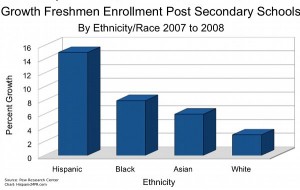
Freshmen Enrollment Growth by Ethnicity/Race – click to enlarge
What are young people in America to do during this recession? Enroll in college. There is a college boom taking place and it is being driven by minorities, according to a recent Pew Research Center
article based on the organization’s analysis of new data from the United States Department of Education.
There was an increase of 144,000 freshman students from the fall of 2007 to the fall of 2008, the first year of the recession, at the nation’s 6,100 post-secondary institutions representing a 6 percent increase, the largest in 40 years. Almost three-quarters of the growth was from minority freshmen.
From 2007 to 2008 although there was only a 3 percent increase in freshman college enrollment of whites, minority enrollment was noteworthy. Hispanics enrollment at post secondary institutions grew 15 percent, blacks enrollment grew 8 percent, and Asian enrollment grew 6 percent.
Of course the growth is not spread evenly across the country. Cities with historically large ethnic, especially Hispanic, populations may have markedly higher increases and an overall higher ethnic presence. An example is South Florida.
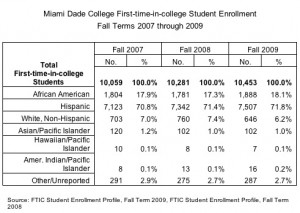
Click on image to enlarge
“MDC’s enrollment growth reflects the community we serve: more than 80 percent of Miami-Dade’s residents are racial or ethnic minorities, with Hispanics predominating. In the 2000 Census 57 percent of Miami-Dade County residents were Hispanic, increasing to 62 percent in the latest estimates. Hispanics at MDC have increased steadily as a proportion of overall student enrollment from 2007 through 2009, and even more so as a percentage of freshman enrollment,” said Margaret Mannchen, associate director, Institutional Research Operations, Miami Dade College, one of the largest post-secondary institutions in the country in both number of students enrolled (170,000) and number of associates degrees awarded
“Now Hispanics are about 72 percent of our first-time-in-college students. Looking at all credit students, we see both African American and White Non-Hispanic percentages declining slightly from Fall 2007 through Fall 2009. In 2009, however, the proportion of African American freshmen was starting to show an increase, after a slight decline in 2008.”
The growth is not surprising given the demographic profile of the United States. As the white population ages it is the minority youth that fuel the nation’s growth. In addition, Census Bureau surveys indicate the Hispanic high school completion rate reached an all-time high of 70 percent in October 2008, a 2.5 percent increase over 2007 and the largest increase of any ethnic or racial group.
Although in the past minority students tended to seek community colleges and trade schools, the growth from 2007 to 2008 was at all basic levels of post secondary education. At the same time, a lower percent of white freshmen enrolled in less-than-four-year schools in 2008 (53 percent) than in 2007 (55 percent); and in four-year schools in 2008 (62 percent) than in 2007 (64 percent).
Of course not all institutions of higher learning showed an increase for that time period. One private university in South Florida had a decrease in enrollment numbers.
“Unfortunately I don’t know that 2008 would be a good bench as nationally there was a decrease in overall enrollment due to the financial crisis and the availability of credit. The numbers picked up again sharply for 2009 and we are currently tracking for 2010 at about a 2-3% increase in enrollment. As I look at the applications coming in we are definitely seeing an increase in minority applications and matriculations,” said Andre Lightbourn, dean, Enrollment Management, Saint Thomas University in Broward County.
“According to our institutional fact book amongst the broad categories Black and Hispanic we are probably about flat for 2007, 2008 & 2009. The numbers have increased for foreigners and other ethnic groups. The number of white students has declined in the same period for the last three academic years 2007, 2008 & 2009.”
An executive summary of the Pew Research Center analysis, written by Richard Fry, was published June 16, 2010. The Pew Research Center, a self described nonpartisan provider of information on “the issues, attitudes and trends shaping America and the world.”
Posted by Elena del Valle on July 26, 2010
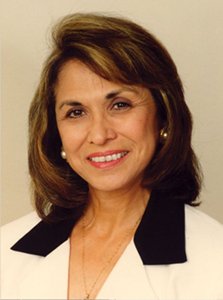
Hernandez, president and founder, Imagen Foundation and executive producer, Imagen Awards
Photo: Imagen Foundation
A podcast interview with Helen Hernandez, president and founder, Imagen Foundation and executive producer, Imagen Awards is available in the Podcast Section of Hispanic Marketing & Public Relations, HispanicMPR.com. During the podcast, Helen discusses the Foundation and 2010 Imagen Awards with Elena del Valle, host of the HispanicMPR.com podcast.
Prior to establishing the Imagen Foundation, Helen was the vice president of Public Affairs for Embassy Communications (now Sony Pictures Entertainment). As the major television production company’s local and national liaison, she was instrumental in developing and supervising corporate programs to enhance the company’s reputation in the national community for socially and culturally sensitive programming. Helen began her career as a labor union organizer for the United Furniture Workers of America.
To listen to the interview, scroll down until you see “Podcast” on the right hand side, then select “HMPR Helen Hernandez” click on the play button below or download the MP3 file to your iPod or MP3 player to listen on the go, in your car or at home. To download it, click on the arrow of the recording you wish to copy and save it to disk. The podcast will remain listed in the July 2010 section of the podcast archive.
Posted by Elena del Valle on July 23, 2010

La belleza de saber vivir book cover
Photo: Grupo Nelson
Barbara Palacios, Miss Universe 1986, banked on her beauty queen reputation to gain the attention of potential readers and fans for a Spanish language book she published recently in the United States. In La belleza de saber vivir 9 pasos para conducir tu vida (Grupo Nelson, $14.99) she shares insights about her philosophy of life and the importance of religion in her life.
The 224-page hardcover book is divided into nine chapters, one for each of the nine steps she proposes her readers follow to live a fulfilling and faith oriented life: La Aceptación, El Enfoque, El Equilibrio, El Liderazgo, El Optimismo, La Gratitud, El perdon, La Dignidad and La Fe. The chapters represent what she considers life’s important paths: acceptance, vision, balance, leadership, optimism, gratitude, forgiveness, dignity and faith.
According to her biography, Palacios’ business ventures include several advertising agencies. She also leads her own company, BP Group featuring her own line of jewelry, beauty products and several stores that bear her name across the United States. The motivational speaker lives in Miami with her husband and two sons.

Click here to buy La belleza de saber vivir (Spanish Edition)
Comments:
Filed Under: Books
Posted by Elena del Valle on July 22, 2010
Information provided by our Event Partner

Connected Marketing Week (August 16-20)
San Francisco, California
August 16-20, 2010
ClickZ, in the first ever all digital marketing festival, has launched Connected Marketing Week (August 16-20 in San Francisco) bringing together the most important voices in email, search, social media, and advertising.
Over five themed days, Connected Marketing Week will play host to 6 education and training focused events including Ad Networks and Exchanges co-programmed by the IAB Networks and Exchanges Committee, Jeff Pulver’s 140 Character Conference, SES San Francisco, the Online Marketing Summit, and the E-mail Experience Council’s Optimization forum. Each conference will revolve around one key idea – how are and will brand advertisers engage with their customer’s online.
Register before July 30th and SAVE up to $300 off an All Access Pass. Enter 15MPR and SAVE an additional 15% off the current rate.
With more than 8000, marketers, programmers, designers, small business owners, affiliates, and more expected to attend – this IS the interactive event of the year.
Our Program Offers:
Conference/Forum Sessions
• Industry Leaders’ Insight
• Expert Panel Discussions
• Relevant Case Studies
• Free Individual Consultant Reviews
Classroom Training
• Classroom-Style Training
• Individual Attention
• Informal Group Discussion
• Actionable Personalized Takeaways
Visit: www.connectedmarketingweek.com?utm_source=hispanicmpr
Posted by Elena del Valle on July 21, 2010
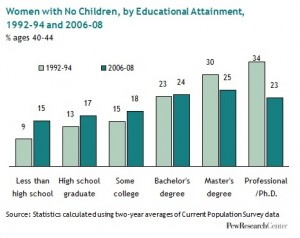
Childless women by educational level – click to enlarge
Graphs: Pew Research Center
In the United States, white women are among all ethnic and racial groups the most likely not to have had a child over the past decade. Over that time period the gap between groups has narrowed with childless rates rising more rapidly for black, Hispanic and Asian women, than for white women. Not surprisingly, women who have never married are most likely to be childless. At the same time, those rates have declined over the past decade and the rate of childlessness has risen for married women and women who were married at one time, according to a recent report from the Pew Research Center.
In 2008, 20 percent or one in every five white women between 40 and 44 years of age was childless. That same year, 17 percent of black and Hispanic women and 16 percent of Asian women in that age group were also without children. Between 1994 and 2008, the rates of childlessness increased more for nonwhites than for whites: the childlessness rates for black women and for Hispanic women went up by more than 30 percent while the increase among white women was 11 percent.
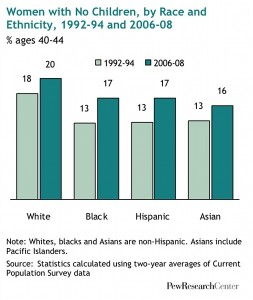
Childless women by race/ethnicity – click to enlarge
This is a sharp contrast to the rates in the 1970s when only 10 percent of white women reached the end of their childbearing years without ever becoming a mother. Although the most educated women are the most likely never to give birth to a child, the exception to the childlessness rates increase was among women with advanced university degrees where the rate fell in the past 10 years. In 2008, 24 percent of women ages 40 to 44 with a master’s, doctoral or professional degree had not had children, a decline from 31 percent in 1994.
The researchers believe childlessness increased for several reasons. Women today endure less social pressure to have children than in past decades. Improved contraceptive methods and better job options for women were also cited as influencing women’s decision to not have children. Women, especially educated women, have delayed marriage and having children, the researchers explain in the report.
Another factor is that some women do not give birth but raise adopted children. In 2008, there were 61.6 million biological children, 1.6 million adopted children and 2.5 million stepchildren in United States homes (2008 American Community Survey).
The report, Childlessness Up Among All Women; Down Among Women with Advanced Degrees, was written by Gretchen Livingston and D’Vera Cohn of the Pew Research Center and released June 25, 2010. They based their findings on Current Population Survey data. The Pew Research Center, a self described nonpartisan provider of information on “the issues, attitudes and trends shaping America and the world.”
Posted by Elena del Valle on July 20, 2010
Information provided by our Event Partner
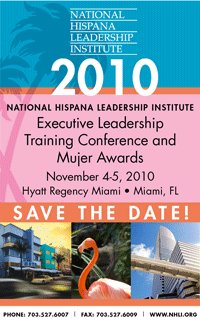
November 4-5, 2010
Miami, Florida
Going on its tenth year, the National Hispana Leadership Institute’s 2010 Executive Leadership Training Conference and Mujer Awards brings together Latinas and NHLI’s accomplished alumnae for two days of cutting-edge leadership and professional development, networking, educational and inspirational keynotes and workshops facilitated by top-level Latinas from across the country.
Visit http://www.nhli.org/sponsors.html for details.
Posted by Elena del Valle on July 19, 2010

A scene in Papas Brujería
Photos, videos: Heineken USA
Heineken USA is relying on Mexican humor and folklore to win the loyalty of Mexican Newcomer consumers, Mexican men between 21 and 34 years of age living in the United States less than 10 years. The beer maker recently launched Tecate Light Papas, a broadcast, out-of-home and retail marketing campaign, including three Spanish language 30-second ads filmed and produced in Mexico City, Mexico, for Tecate Light. Scroll down to watch the three ads in Spanish.
The Tecate Light Papas television commercials, which took three months to film and produce in Mexico, are scheduled to air concurrently from May to September 2010 on Univision, Telemundo, Azteca America and Estrella TV in markets where the beer is available, including Arizona, California, and Texas.

Christian McMahan, chief marketing officer, Heineken USA
“With this installment of Tecate Light’s Papás campaign, we’re creating continuity of two characters that connect emotionally with the brand’s core consumer, Mexican men making a living in the U.S. Most importantly, by incorporating humoristic and visual elements that only they would understand, Tecate Light is further positioned as an authentic Mexican light cerveza that offers them much more than just another light beer option,” said Christian McMahan, chief marketing officer, Heineken USA.
The three spots, peppered with Mexican slang, humor and culture and the brand tagline “Por los que quieren más” (“For those who want more”), feature two Mexican parents whose son, José, lives in the United States and drinks light beers that, according to the ads, don’t compare to the flavor of Tecate Light.

A scene in Papas Garrafon
In one of the ads, for example, the mother, who believes that her son has been cursed into drinking other brands, performs a limpia, or a cleansing, on his portrait. In the second commercial, the parents become clearly agitated as the local water boy walks by the house offering his services, reminding them that their son prefers watered down beers.

A scene in Papas Gringos, the third ad with replacement parents
In the third ad an American couple pretend to be José’s parents and talk to him in a heavily-accented Spanish. Soon his real mother and father appear saying “Since you keep drinking light beer from over there, does it mean you’re also looking to replace us?” The ad closes with the American and Mexican dads comparing their pronunciation of light beer.
The three commercials were directed by Simón Bross, who also help create Tecate’s Anthem 3 campaign released in April 2010 (see Heineken launches new Tecate Spanish language ad campaign targeting men 21 to 34). Adrenalina, the brand’s advertising agency, created the ads; Media Vest’s MV42 Degrees handled the media buy.

Manuel Wernicky, president, Adrenalina
“The Papás have become iconic characters who represent the different mindsets newcomers experience as they straddle two worlds,” said Manuel Wernicky, president, chief ideas officer and managing partner, Adrenalina.
Posted by Elena del Valle on July 16, 2010

Mañana in Cuba
Photos: Tara Inc.
In Mañana in Cuba The Legacy of Castroism and Transitional Challenges for Cuba (Authorhouse, $24.95), a 184-page English language softcover book published this year, Jose Azel, Ph.D. addresses the possible future situation in Cuba, the country of his birth. He examines the issues that he believes afflict the island nation with an emphasis on challenges and opportunities.
In the book, he offers policy approaches based on what he assesses to be the current situation and Cuban mindset on the island he has not seen since his youth. He also discusses the potential benefits he sees for the United States if the Castro ruled nation one day becomes a democracy. And, he explores the concept of Choice Architecture based on “the lessons learned in Eastern Europe.”
“The book is a little history, political science, a little philosophy, psychology, sociology just very multidisciplinary which I think reflects my own thinking,” said Azel. He explained by phone that although much has been written about the past of Cuba this book is novel because of its focus on that country’s future.
The University of Miami logo and the words “Institute for Cuban and Cuban-American Studies University of Miami Coral Gables, Florida” appear at the beginning of the book. One hundred percent of the author proceeds of the book are designated to benefit the Institute with which he is affiliated.
The book is divided into two parts and thirteen chapters. The chapters in Part One are: Cuba: Alternative Roads in an Uncertain Future; Freedom from Fear; Search for Meaning; The First Law; No Le Pidas Peras Al Olmo; Carajo, Somos como Somos; Cuban Informality and Choice Architecture; and The Pursuit of Happiness. The chapters in Part Two are: Personnel Reforms; Institutional Reforms; Political Reforms; Economic Reforms; and Concluding Thoughts.
In his conclusion Azel states that “The most insidious and devastating legacy of Castroism is that Cuban society, living in constant fear, has forgotten how to feel free.” And that “… promoting a Cuban society that relearns how to feel free should be a common denominator of all mañana in Cuba visions.

Author Jose Azel, Ph.D.
Azel left Cuba in 1961 as a 13 year-old political exile in the Operation Pedro Pan, a child refugee program. A senior scholar at the Institute for Cuban and Cuban-American Studies (ICCAS) at the University of Miami he dedicates his time to the in-depth analysis of Cuba’s economic, social, and political state. He has a particular interest in post-Castro Cuba strategies. It took him a year of intense writing to complete the book.

Click here to buy Mañana In Cuba
Comments:
Filed Under: Books
Posted by Elena del Valle on July 14, 2010
By Robin Blakely
Partner, Get There Media
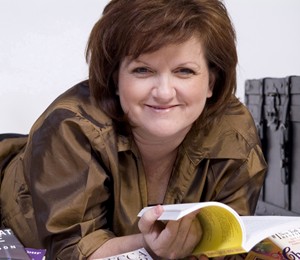
Robin Blakely, partner, Get There Media
Photo: Get There Media
So you have a book, you’ve established a Latino following, and now you have your eye on the mainstream marketplace. Here are four key things you need to know to leverage your culture and connections to keep your momentum mobilized.
1. Focus on a different kind of culture.
Stop thinking of your audience as Latino or not Latino. Transcend that way of thinking. Instead, think of your target market as gifted, or funny, or heartbroken, or entrepreneurial. Focus on who they are as clean freaks, or foodies, or mystery lovers, or knitters. Your audience—whoever they are—has a culture of its own that doesn’t have to be described as Latino or non-Latino. Think about the culture your audience shares as a group. Without relying on a description that involves ethnicity, ask yourself:
Click here to read the complete article

Click here to buy PR Therapy































